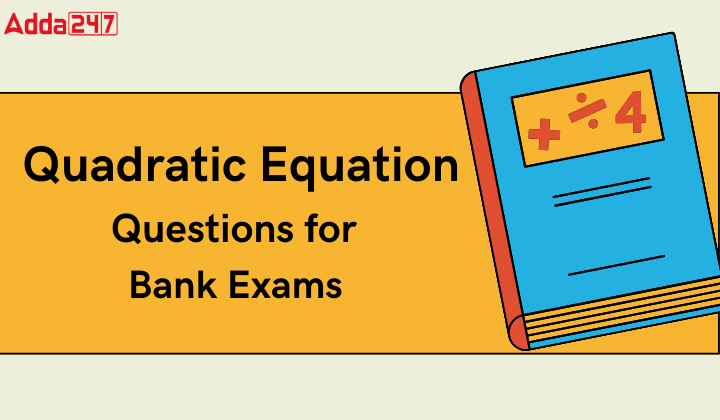Table of Contents
Quadratic Equations For Bank Exams
Quadratic equation is a fundamental topic in mathematics, and their understanding is crucial for success in bank exams. Among the various topics covered in this section, quadratic equations hold significant importance due to their frequent appearance in exams. Mastering the concepts and problem-solving techniques related to quadratic equations can give aspirants a considerable advantage in securing a position in the banking sector.
What is a Quadratic Equation?
A quadratic equation is a polynomial equation of degree two, typically represented as ax2 + bx + c = 0 where a, b, and c are real numbers, and a ≠ 0. The solutions to quadratic equations are known as roots or zeroes (two distinct real roots, one real root, or complex roots, depending on the values of a, b, and c.)
Types of Quadratic Equations
- Factorizable Quadratic Equations: These equations can be factored into linear factors. For example, (x – 2)(x + 3) = 0.
- Roots of Quadratic Equations: The roots of a quadratic equation can be found using the quadratic formula: x = [-b ± √(b2 – 4ac)] / (2a).
- Nature of Roots: Based on the discriminant (b2 – 4ac), quadratic equations can have real and distinct roots, real and equal roots, or complex roots.
How to Solve Quadratic Equations
- Factorizable Quadratic Equations: Factorizing quadratic equations is one of the simplest methods, especially when the equation is factorizable.
- Identify common factors and attempt to factorize the quadratic expression.
- Example: 𝑥2 − 5𝑥 + 6 = 0 can be factored as (𝑥−2) (𝑥−3)=0.
- Solve each factor individually to find the roots, i.e. 𝑥 = 2, 3.
- Quadratic Equations Requiring the Quadratic Formula:
- Use the quadratic formula:

- Substitute the values of 𝑎, 𝑏, and 𝑐 from the given quadratic equation.
- Compute the discriminant (𝑏2−4𝑎𝑐) to determine the nature of roots.
- Example: 2𝑥2 + 5𝑥 − 3 =0.
- Here, 𝑎=2, 𝑏=5, and 𝑐=−3
- Substitute these values into the quadratic formula and solve for 𝑥.
- So 𝑥= 1/2, −3.
- Use the quadratic formula:
- Word Problems Involving Quadratic Equations:
- Translate the given problem into a quadratic equation.
- Example: “The product of two consecutive integers is 42. Find the integers.”
- Let 𝑥 represent the smaller integer. The next consecutive integer is 𝑥+1.
- Form the equation: 𝑥(𝑥+1)=42.
- Solve the quadratic equation to find the integers.
- So, 𝑥 = 6; 𝑥+1=7
Importance of Quadratic Equation
Quadratic equations are a fundamental part of the quantitative aptitude syllabus for bank exams. They frequently appear in problem-solving scenarios involving areas such as age problems, time and work problems, profit and loss calculations, and geometric applications. Proficiency in solving quadratic equations is essential for tackling these diverse problem types.
Strategies for Solving Quadratic Equations in Bank Exams
- Identify the type of quadratic equation and choose the appropriate solution method.
- Practice solving quadratic equations by factorization, as it is often the quickest and most efficient method.
- For equations that cannot be solved by factorization, apply the quadratic formula or the method of completing the square.
- In word problems, carefully read the problem statement and identify the relevant variables and equations.
- Practice extensively with a variety of quadratic equation problems from previous years’ bank exam question papers and mock tests.
Practice Questions for Bank Questions
Directions (1-5): In each of these questions, two equations (I) and (II) are given. You have to solve both equations and give the answer
(a) If x>y
(b) If x≥y
(c) If x<y
(d) If x≤y
(e) If x = y or no relation can be established between x and y
Q1. I. x2 + 13x – 114 = 0
II. y3 = 216
Q2. I. x2 − 6𝑥 + 12 = 4
II. y2 + 4𝑦 − 10 = −13
Q3. I. 12x2 − 7𝑥 + 1 = 0
II. 20y2− 9𝑦 + 1 = 0
Q4. I. x2 + 26𝑥 + 165 = 0
II. y2+ 23𝑦 + 132 = 0
Q5. I. x2 + 𝑥 − 6 = 0
II. 15y2− 11𝑦 + 2 = 0
Direction (6 – 10): In each of the following questions two equations are given. Solve these equations and give the answer:
(a) if 𝑥 ≥ 𝑦, i.e., 𝑥 is greater than or equal to 𝑦
(b) if 𝑥 > 𝑦, i.e., 𝑥 is greater than 𝑦
(c) if 𝑥 ≤ 𝑦, i.e., 𝑥 is less than or equal to 𝑦
(d) if 𝑥 < 𝑦, i.e., 𝑥 is less than 𝑦
(e) 𝑥 = 𝑦 or no relation can be established between 𝑥 and 𝑦
Q6. (i) x2 + 9 = 73
(ii) y2 = 512
Q7. (i) x2 + 11x + 18 = 0
(ii) y2 + 19y + 90 = 0
Q8. (i). x2 − 10𝑥 + 21 = 0
(ii). y2 – 5𝑦 + 6 = 0
Q9. (i) 2x2 + x − 1 = 0
(ii) 2y2 + 3y + 1 =0
Q10. (i). 2x2 + 13x + 21 = 0
(ii). 2y2 + 11y + 14 = 0
Direction (11 – 15): In each of these questions, two equations (I) and (II) are given. You have to solve both the equations and give the answer.
(a) If x=y or no relation can be established.
(b) If x>y
(c) If x<y
(d) If x≥y
(e) If x≤y
Q11. (I) x3 – 12 – 1319 = 0
(II) y2 – 21 – 100 = 0
Q12. I. 12x2 − 7𝑥 + 1 = 0
II. y2 + 23𝑦 + 132 = 0
Q13. (I) x2 + 9x – 52 = 0
(II) 12y2 + 16y + 4 = 0
Q14. (I) x2 – x – 210 = 0
(II) y2 – 31y + 240 = 0
Q15. (I) 2x2 – 8x – 24 = 0
(II) 9y2 – 12y + 4 = 0
Directions (16-20): In each question, two equations (I) and (II) are given. You should solve both equations and mark the appropriate answer.
(a) If x > y
(b) If x ≥ y
(c) If x < y
(d) If x ≤ y
(e) If = y or the relationship cannot be established.
Q16. I. 2x² – 7x + 5 = 0
II. y² – 3y + 2 = 0
Q17. I. x² – 25x + 156 = 0
II. y² – 29y + 210 = 0
Q18. I. x² + 20x + 96 = 0
II. y² + 15y + 56 = 0
Q19. I. x² – 3x – 40 = 0
II. 2y² + 11y + 15 = 0
Q20. I. x² – 16x + 64 = 0
II. y² – 14y + 48 = 0
| Solutions | |||||||||
| 1 | d | 2 | a | 3 | b | 4 | e | 5 | e |
| 6 | c | 7 | a | 8 | a | 9 | e | 10 | e |
| 11 | d | 12 | b | 13 | a | 14 | e | 15 | a |
| 16 | e | 17 | c | 18 | d | 19 | e | 20 | b |





 GA Capsule for SBI Clerk Mains 2025, Dow...
GA Capsule for SBI Clerk Mains 2025, Dow...
 The Hindu Review October 2022: Download ...
The Hindu Review October 2022: Download ...
 SBI PO Mains Admit Card 2025 Out, Downlo...
SBI PO Mains Admit Card 2025 Out, Downlo...


